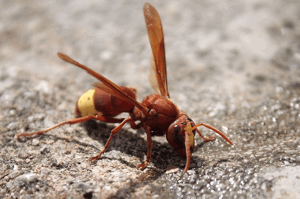Science Note
Air Date: Week of February 11, 2011

The Oriental Hornet. (Photo: Matti Paavola- Wikimedia Creative Commons)
Researchers discover that the Oriental Hornet can convert sunlight into energy. Scientists look to imitate the insect's body structure and apply it to solar technology. Wynn Tucker reports.
Transcript
GELLERMAN: Coming up – oceanography and poetry. I think I shall never see….a poem lovely as the sea. But first, this note on emerging science from Wynn Tucker.
[MUSIC: GREEN HORNET THEME]
TUCKER: Another challenge for the Green Hornet: harness the awesome power of the sun.
[SCIENCE NOTE THEME]
TUCKER: A new kind of ‘green hornet’ has caught the attention of scientists at Tel Aviv University. The Oriental Hornet can be found from the Middle East to India, and it has the ability to convert sunlight into energy. Unlike other flying insects, this hornet is most active during the middle of the day, when the sun shines the brightest. Scientists discovered that its body acts as a solar panel.

The Oriental Hornet. (Photo: Matti Paavola- Wikimedia Creative Commons)
The exoskeleton of the oriental hornet is brown with a ring of yellow around its abdomen. The brown section of the exoskeleton is covered with tiny grooves that trap light. The yellow ring gets its color from a pigment called Xanthopterin, which converts the sunlight into energy.
The hornet uses this energy to build its nest. Researchers hope to apply the structure of the hornetÂ’s exoskeleton to solar panels. If this does lead to a more cost-effective solar panel, the oriental hornet could take the sting away from the high prices of solar technology.
ThatÂ’s this weekÂ’s Note on Emerging Science, IÂ’m Wynn Tucker.
Links
The original paper as published in the journal Naturwissenschaften
Living on Earth wants to hear from you!
Living on Earth
62 Calef Highway, Suite 212
Lee, NH 03861
Telephone: 617-287-4121
E-mail: comments@loe.org
Newsletter [Click here]
Donate to Living on Earth!
Living on Earth is an independent media program and relies entirely on contributions from listeners and institutions supporting public service. Please donate now to preserve an independent environmental voice.
NewsletterLiving on Earth offers a weekly delivery of the show's rundown to your mailbox. Sign up for our newsletter today!
 Sailors For The Sea: Be the change you want to sea.
Sailors For The Sea: Be the change you want to sea.
 The Grantham Foundation for the Protection of the Environment: Committed to protecting and improving the health of the global environment.
The Grantham Foundation for the Protection of the Environment: Committed to protecting and improving the health of the global environment.
 Contribute to Living on Earth and receive, as our gift to you, an archival print of one of Mark Seth Lender's extraordinary wildlife photographs. Follow the link to see Mark's current collection of photographs.
Contribute to Living on Earth and receive, as our gift to you, an archival print of one of Mark Seth Lender's extraordinary wildlife photographs. Follow the link to see Mark's current collection of photographs.
 Buy a signed copy of Mark Seth Lender's book Smeagull the Seagull & support Living on Earth
Buy a signed copy of Mark Seth Lender's book Smeagull the Seagull & support Living on Earth

